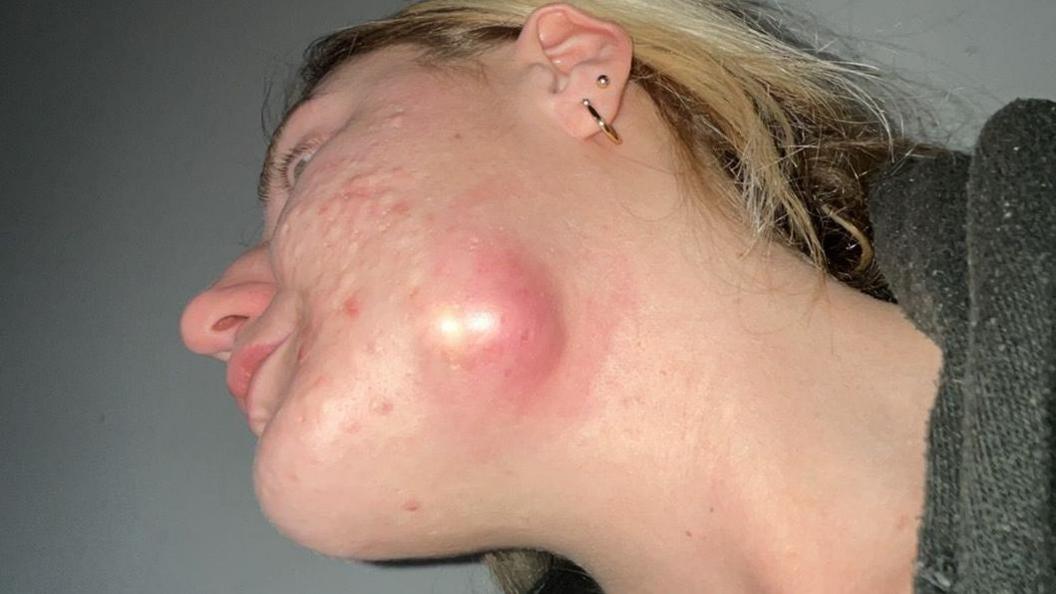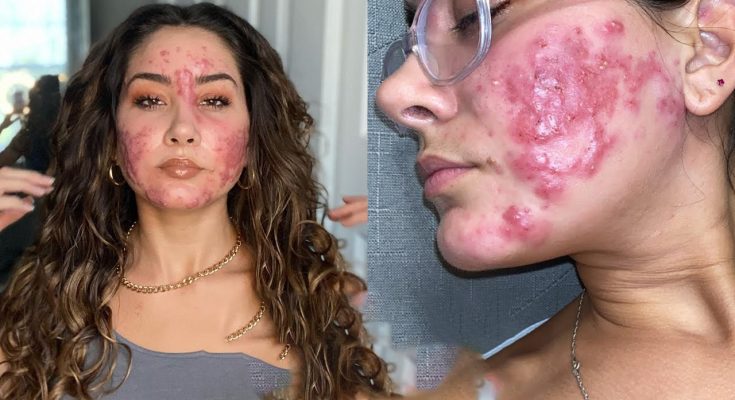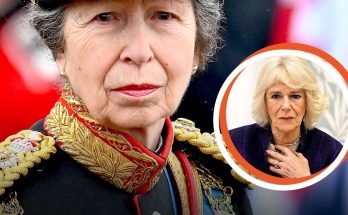A WOMAN has told of how baring her face on social media has helped her accept her cystic acne. Throughout her teenage years, Karen, now 28, had clear skin. But then, in her early twenties, she was hit by an outbreak of cystic acne. In May 2021, she also developed rosacea, leaving her in so much pain that she would often wake up to a bloodied pillow, and found that even smiling hurt. Her confidence was so impacted that she would not even let her own family see her without makeup. Then one day, she was scrolling Instagram, when she came across the #acnepositivity community – thousands of people sharing unfiltered photos of their skin in a bid to normalize acne and fight back against stigma. Realizing her own story could help others, she took the plunge and shared a barefaced selfie – the first thing she had posted on social media in five years. Now, she continues to share her story in the hope she can inspire others. She concluded: “Now, I look at my textured skin and I embrace it. I’m proud of my body and how hard it works daily.”

Social media has transformed into a platform for individuals to share not only the highlights of their lives but also their struggles and insecurities. One such story that has resonated deeply with many is that of a woman who has used her platform to bare her face and journey with cystic acne. Her story is one of courage, self-acceptance, and empowerment, providing hope and encouragement to thousands of people dealing with the emotional and physical challenges of severe acne.
The Start of Her Journey
For as long as she could remember, she struggled with cystic acne. What started as occasional breakouts during her teenage years quickly turned into a persistent, painful condition that followed her into adulthood. Cystic acne, the most severe form of acne, involves deep, painful lesions that often lead to scarring. Unlike mild acne, which can be easily concealed with makeup or managed with over-the-counter treatments, cystic acne is harder to hide and more resistant to common treatment options.
During her early 20s, she felt immense pressure to present herself as flawless on social media. Platforms like Instagram, filled with curated images of perfect skin and seemingly effortless beauty, only intensified her insecurities. She tried everything — from high-end skincare products to dermatologist-prescribed medications — but nothing seemed to work. No matter how hard she tried, the cystic acne persisted.
Her confidence plummeted. She found herself avoiding social situations and using heavy makeup to cover up her blemishes whenever she left the house. On days when her acne was particularly bad, she would cancel plans altogether. She even considered quitting social media, believing that her acne would prevent her from ever fitting into the beauty standards that were so prominently displayed on her feed.

### The Turning Point
The turning point came when she stumbled upon a community of individuals online who were openly sharing their struggles with skin conditions. This group wasn’t afraid to post unfiltered photos of their acne, scars, and other imperfections. For the first time, she realized that she wasn’t alone. There were countless others experiencing the same frustrations and emotional pain that she was. Inspired by their bravery, she decided to take a leap of faith and post a photo of herself without makeup, acne and all.
The response was overwhelming. What she expected to be met with criticism and judgment instead received an outpouring of support. People commented on how much they admired her honesty and vulnerability. Many thanked her for showing what real skin looked like, stating that her post made them feel less alone in their own struggles. It was a pivotal moment for her — one that changed the way she viewed both her acne and herself.
### Embracing Her Skin
After that first post, she began to document her journey with cystic acne more regularly on social media. She shared everything: the bad days when her skin felt like it was on fire, the days when her confidence was low, and the moments of progress when she noticed her skin healing. Each post was a raw, honest depiction of what it was like living with cystic acne.
As she continued to share her story, her following grew. People from all over the world, many of whom were struggling with their own skin issues, flocked to her page for support and advice. She became a voice of empowerment, encouraging others to embrace their skin as it was, imperfections and all. Through her posts, she emphasized that having acne doesn’t make someone any less worthy of love, success, or happiness.

Her newfound confidence in baring her skin came with a powerful realization: She didn’t need flawless skin to be beautiful or to feel good about herself. By accepting her acne, she took back control of her narrative. Instead of hiding behind layers of makeup or staying silent about her insecurities, she embraced them fully.
### The Emotional Toll of Acne
Living with cystic acne isn’t just a physical challenge — it’s an emotional one as well. For her, the condition had taken a toll on her self-esteem for years. She vividly remembered the stares from strangers and the unsolicited advice she would receive from well-meaning friends and family members. Comments like, “Have you tried drinking more water?” or “Maybe it’s your diet,” only added to her frustration.
At times, she felt like her skin was all anyone could see when they looked at her. No matter how stylish her outfit was or how much effort she put into her appearance, the red, inflamed bumps on her face seemed to overshadow everything else. It was a constant battle to remind herself that she was more than her acne — that her worth wasn’t tied to her appearance.
Depression and anxiety often go hand in hand with severe acne. In her case, the anxiety of attending social events and the fear of judgment was something she struggled with regularly. But over time, through therapy, journaling, and the support of her online community, she learned to manage these feelings. Sharing her journey online became a form of therapy in itself. By vocalizing her struggles, she found solace in knowing that she wasn’t facing them alone.
### Building a Supportive Community
Her social media page quickly transformed from a personal diary into a safe space for others to share their stories. She started receiving messages from people who were inspired by her posts to show their real skin for the first time. Many expressed that they had spent years feeling ashamed of their acne, hiding behind makeup and filters, but her transparency gave them the courage to step into the light.
The community she built became a place of mutual encouragement, where people could discuss their skincare routines, share tips, and most importantly, offer emotional support. While the internet can often be a place of negativity, her platform was an exception. People showed up with kindness, empathy, and understanding. This network of support was invaluable to her and her followers, proving that vulnerability can foster incredible connections.
### Advocacy for Acne Awareness
As her platform grew, so did her influence. She began partnering with dermatologists, skincare brands, and mental health professionals to raise awareness about the emotional toll of severe acne. While there are plenty of resources available for treating the physical symptoms of acne, she realized there was a lack of conversation around the psychological impact.
She started speaking out about the importance of mental health support for individuals with acne. Many people don’t realize that acne can lead to feelings of isolation, depression, and in severe cases, even suicidal thoughts. By openly discussing these issues, she hoped to reduce the stigma surrounding acne and encourage others to seek help when needed.
### Navigating the Beauty Industry
In addition to advocating for mental health, she also became an outspoken critic of the beauty industry’s unrealistic standards. She called out brands that only featured models with airbrushed, flawless skin, and she pushed for more representation of real, unedited skin in beauty campaigns. Her goal was to help shift the narrative around what “beautiful” skin looks like.
In collaboration with a few progressive skincare brands, she even launched a campaign promoting the concept of “skin positivity” — the idea that all skin, no matter its condition, is beautiful and deserves to be celebrated. The campaign featured people with acne, rosacea, eczema, and other skin conditions, all proudly showing their faces without filters or retouching. It was a groundbreaking moment that challenged the industry’s obsession with perfection.
### Personal Growth and Acceptance
Through sharing her journey, she experienced immense personal growth. She learned that self-acceptance is not a destination but an ongoing process. There are still days when she feels insecure about her skin, and that’s okay. What matters is that she no longer feels defined by her acne. It’s a part of her, but it doesn’t control her.
By embracing her flaws and sharing her truth, she’s inspired countless others to do the same. Her story is a reminder that true beauty comes from confidence, self-love, and authenticity — not from perfect skin.
### Conclusion
Her journey of self-acceptance through social media is a powerful example of how vulnerability can lead to empowerment. By baring her face and sharing her struggles with cystic acne, she has created a community that uplifts and supports one another. Through her advocacy, she is challenging societal beauty standards and raising awareness about the emotional toll of acne. More importantly, she is reminding people everywhere that they are more than their skin, and that true beauty lies in embracing oneself fully, flaws and all.



